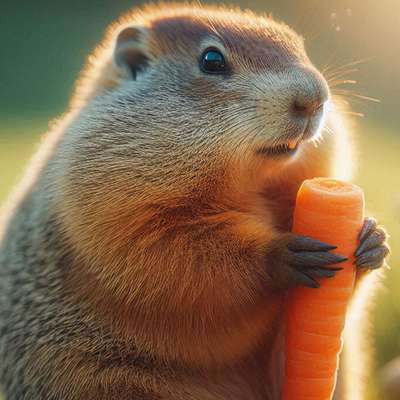What Kind of Plants Do Groundhogs Eat?
Groundhogs are herbivorous rodents with a diverse palate when it comes to plant matter. These furry creatures are opportunistic eaters, consuming a wide variety of vegetation found in their habitats.
Groundhogs typically prefer tender, young plants and will eat both wild and cultivated species. Their diet changes seasonally based on availability, with a focus on building fat reserves in late summer and early fall to prepare for hibernation.
While groundhogs will eat many types of plants, they do have preferences.
Here's a list of common plants that groundhogs eat:
- Grasses and clovers
- Alfalfa
- Dandelions
- Wild lettuce
- Plantain
- Chickweed
- Violets
- Garden vegetables (e.g., beans, peas, carrots, lettuce)
- Fruits (e.g., apples, berries)
- Agricultural crops (e.g., soybeans, corn)
- Tree bark and twigs
- Leaves from various trees and shrubs
- Flowers (both wild and cultivated)
- Herbs (e.g., mint, oregano, parsley)
- Ferns
This diverse diet allows groundhogs to adapt to various environments and maintain their nutritional needs throughout the active months of the year.
Groundhogs typically prefer tender, young plants and will eat both wild and cultivated species. Their diet changes seasonally based on availability, with a focus on building fat reserves in late summer and early fall to prepare for hibernation.
While groundhogs will eat many types of plants, they do have preferences.
Here's a list of common plants that groundhogs eat:
- Grasses and clovers
- Alfalfa
- Dandelions
- Wild lettuce
- Plantain
- Chickweed
- Violets
- Garden vegetables (e.g., beans, peas, carrots, lettuce)
- Fruits (e.g., apples, berries)
- Agricultural crops (e.g., soybeans, corn)
- Tree bark and twigs
- Leaves from various trees and shrubs
- Flowers (both wild and cultivated)
- Herbs (e.g., mint, oregano, parsley)
- Ferns
This diverse diet allows groundhogs to adapt to various environments and maintain their nutritional needs throughout the active months of the year.
What is a Groundhog's Favorite Food?
You know how it is... Groundhog Day rolls around, everyone's talking about shadows and predicting the weather. But nobody ever asks the real question:
What does a groundhog LIKE to eat? (Besides, you know, maybe a bite of spring?)
See, groundhogs are serious eaters. They spend almost their whole lives thinking about food. They're like the friend who always shows up at your BBQ early just to make sure they get dibs on the burgers.
But unlike your burger-loving buddy, groundhogs are vegetarians. So what's their go-to snack?
Forget the Shadow, It's All About the Greens:
• Clover: If clover were cash, groundhogs would be RICH. They can't get enough of this stuff. It's sweet, grows low to the ground, and easy to grab.
• Alfalfa: Think of it like the groundhog version of a superfood smoothie. Packed with nutrients and delicious.
• Dandelions: Those yellow flowers your neighbor hates? Groundhogs consider them a gourmet salad.
These aren't the only things groundhogs munch on, they're just the VIPs (Very Important Plants) of the groundhog diet.
Why? Because:
• Easy Access: All these plants grow low to the ground, right where groundhogs like to hang out. No need to climb trees!
• Tasty AND Healthy: Think of it like a salad bar that's actually delicious.
So there you have it. The next time you see a chubby groundhog waddling around, you'll know exactly what it's dreaming of: a big, leafy plate of clover, alfalfa, and dandelion delight.
What does a groundhog LIKE to eat? (Besides, you know, maybe a bite of spring?)
See, groundhogs are serious eaters. They spend almost their whole lives thinking about food. They're like the friend who always shows up at your BBQ early just to make sure they get dibs on the burgers.
But unlike your burger-loving buddy, groundhogs are vegetarians. So what's their go-to snack?
Forget the Shadow, It's All About the Greens:
• Clover: If clover were cash, groundhogs would be RICH. They can't get enough of this stuff. It's sweet, grows low to the ground, and easy to grab.
• Alfalfa: Think of it like the groundhog version of a superfood smoothie. Packed with nutrients and delicious.
• Dandelions: Those yellow flowers your neighbor hates? Groundhogs consider them a gourmet salad.
These aren't the only things groundhogs munch on, they're just the VIPs (Very Important Plants) of the groundhog diet.
Why? Because:
• Easy Access: All these plants grow low to the ground, right where groundhogs like to hang out. No need to climb trees!
• Tasty AND Healthy: Think of it like a salad bar that's actually delicious.
So there you have it. The next time you see a chubby groundhog waddling around, you'll know exactly what it's dreaming of: a big, leafy plate of clover, alfalfa, and dandelion delight.



